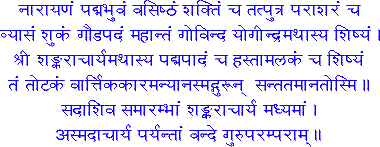![]()

![]()
![]()

![]()
nArAyaNam. padmabhuvam. vasishTham.
Saktim. ca tatputra parASaram. ca
vyAsam. Sukam. gauDapadam. mahAntam. govindayogIndram athAsya
Sishyam. |
SrI Sam.karAcAryam athAsya padmapAdam. ca hastAmalakam. ca Sishyam.
tam. toTakam. vArttikakAramanyAn asmad gurUn santatamAnatosmi ||
sadASiva samArambhAm. SankarAcArya madhyamAm.
asmadAcArya paryantAm. vande guru paramparAm. ||
These are the advaita guru paramparA verses, which salute the
prominent gurus of advaita, starting from nArAyaNa through Sankara and his
disciples, upto the AcAryas of today. It is typical of advaita that the
first guru is called nArAyaNa (vishNu) in the first verse and sadASiva
(Siva) in the second. The paramparA thus lists:
![]() nArAyaNa
nArAyaNa
![]() padmabhuva (brahmA)
padmabhuva (brahmA)
![]() vasishTha
vasishTha
![]() Sakti
Sakti
![]() parASara
parASara
![]() vyAsa
vyAsa
![]() Suka
Suka
![]() gauDapAda
gauDapAda
![]() govinda
bhagavatpAda
govinda
bhagavatpAda
![]() SankarAcArya
SankarAcArya
![]() padmapAda, hastAmalaka, toTaka, sureSvara (vArttikakAra),
padmapAda, hastAmalaka, toTaka, sureSvara (vArttikakAra),
and others (anyA:).
In the Indian religious and philosophical traditions, all knowledge is traced back to the Gods and to the Rshis who saw the vedas. Thus, the advaita guru-paramparA begins with the daiva-paramparA , followed by the Rshi-paramparA, which includes the vedic seers vasishTha, Sakti, parASara, his son vyAsa, (the famous redactor of the vedas, he is also traditionally identified with bAdarAyaNa, the composer of the brahmasUtras), and vyAsa's son Suka. After Suka, we turn to the mAnava-paramparA, which brings us to historical times and personalities. The traditions regarding these human gurus are recorded in the Sankaravijaya literature, and typically, they are regarded as incarnations of various deities. gauDapAda is the famous author of the mANDUkya kArikas that are attached to the mANDUkya upanishad. His disciple, govinda, is regarded as an incarnation of AdiSesha, the cosmic serpent. He was the preceptor of Sankara, who is regarded as an incarnation of Siva. Sankara's four well-known disciples were named padmapAda, hastAmalaka, toTaka and sureSvara (vArttikakAra). Tradition has it that Sankara appointed these four disciples as heads of the four maThas that he founded. The others are the gurus who come later in the tradition.
Sankara and his disciples, padmapAda and sureSvara, are arguably the most important philosophers in the advaita vedAnta tradition. After the mANDUkya kArikAs, Sankara's commentaries to the upanishads, brahmasUtras and bhagavadgItA are the oldest extant vedAnta treatises. The importance of Sankara can be seen from the fact that every vedAntin after him makes his mark either by expanding on his thought or by refuting him.
Sankara can be dated more or less reliably to the 8th century CE. Upto Suka, the first few gurus cannot be dated to historical times. The date of gauDapAda, the author of the mANDUkya kArikAs, is usually inferred from the tradition that he was Sankara's teacher's teacher, and from references to the mANDUkya kArikAs in other works. However, not much historical information is known about govinda bhagavatpAda, Sankara's teacher, except that Sankara salutes him in the invocatory verses in some of his works.
![]()
Last updated on May 5, 1999.
| The advaita home page |